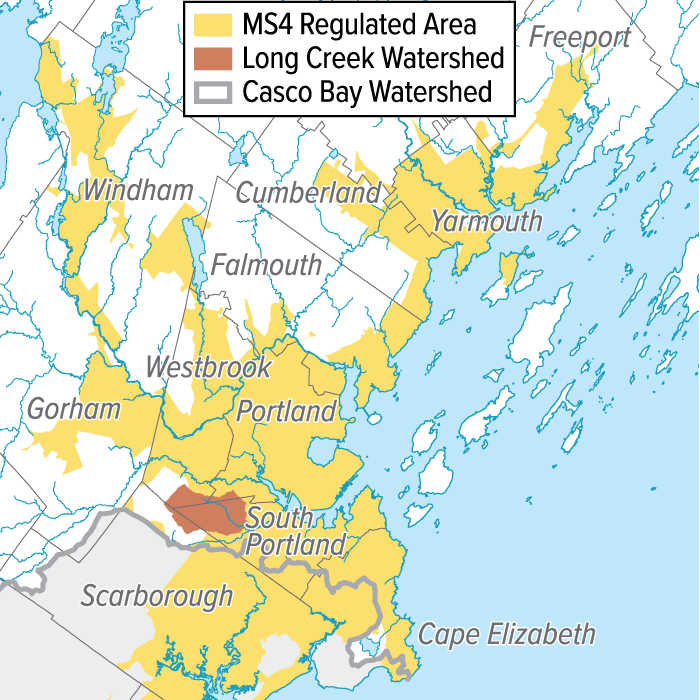Stormwater Runoff Degrades Water Quality
in Urban Streams
Salt from Winter Deicing Products Poses a Threat to Urban and Suburban Waters
WHY IT MATTERS
“Stormwater” refers to runoff that occurs during and soon after rain or during snow melt events. Runoff from roads, parking areas, lawns, and other urban areas carries contaminants, including sediments, petroleum products, toxic metals, winter deicing products, pesticides, fertilizers, human and animal waste, bacteria, and pathogens. In addition, stormwater running off hot pavement in the summer increases temperatures in nearby streams, leading to lower dissolved oxygen levels. In urban or developed areas, stormwater not only adds pollutants, but changes runoff amount and timing. Because rain cannot soak into the ground through roads, parking areas, or roofs (known collectively as “impervious surfaces”), runoff comes fast, increasing risk of flooding, eroding stream channels, and damaging aquatic habitat. Between storms, urban streams are often starved of water, and can even dry completely. The combination of pollutants, warmer water, and disruption of flow adversely affects fish and other aquatic organisms.STATUS
As shown in the Inland Waters section of this report, many Casco Bay streams that do not meet water quality standards are found in urban areas. Long-term data on water quality in urban streams, however, is limited.
The Long Creek watershed includes about three and a half square miles in Portland, South Portland, Westbrook, and Scarborough. It encompasses the Maine Mall and many other businesses, such as hotels, medical facilities, restaurants, and retail stores. Approximately thirty percent of the watershed is impervious surfaces. Less than three percent of subwatersheds in the Casco Bay region have a higher level of imperviousness.
The Long Creek Watershed Management District (LCWMD) has been monitoring water quality in Long Creek for a decade. LCWMD’s data provides the most complete record of urbanwater quality in our region. It documents pollutants in Long Creek such as metals, nutrients, and chlorides, as well as changes in temperature, dissolved oxygen, and flow. Conditions in other urban streams are likely to be similar.
Winter Salt Runoff Affects Freshwater Streams
Salt used to remove ice and snow from roads and parking areas eventually enters streams, where it can be toxic to freshwater organisms. In the graphs below, salts are measured as chlorides.Declining Dissolved Oxygen Levels
Fish and other aquatic organisms require adequate levels of dissolved oxygen in order to thrive. Low levels cause stress, and at very low levels aquatic organisms may suffocate.Municipal Stormwater: MS4 Permit programs
Stormwater finds its way to streams through a system of catch basins, storm sewers, drains, swales, chambers, ditches, ponds, and other conveyances. This oft-forgotten infrastructure–if up to date, and properly designed and constructed–can reduce flooding and protect water quality. While some of this system is privately owned, most is the responsibility of cities and towns.
The Clean Water Act regulates discharge of stormwater, addressing Municipal Separated Storm Sewer Systems (MS4s). Under the MS4 program, municipalities take steps to reduce water quality impacts of stormwater, including public education, reducing stormwater pollution from municipal operations, and passing ordinances to reduce runoff from construction sites. MS4 programs play a significant role in protecting water quality. In the Casco Bay region, the Interlocal Stormwater Working Group coordinates implementation, reducing community costs and helping improve water quality.
Currently, eleven Casco Bay watershed communities have MS4 programs. Requirements are tied not to municipal boundaries or to intensity of land use, but to designation by the U.S. Census of an “urbanized area”. Following the 2020 census, additional towns in the region may fall within official urban areas, and thus be required to implement an MS4 program.
MS4 Programs in Casco Bay Watershed
Cape Elizabeth, Cumberland, Falmouth, Freeport, Gorham, Portland, Scarborough, South Portland, Westbrook, Windham, Yarmouth
successes & challenges
- Reducing the thousands of tons of salt put on roads and parking areas in Maine each winter could save money and protect streams. Public expectations for winter travel and concern about accidents and injuries provide incentives for continued high use. Solutions have proven elusive.
- Much of our region’s urban and suburban landscape lacks modern stormwater infrastructure because it was constructed before standards to minimize risks to water quality. High cost of “retrofitting” stormwater treatment in urbanized areas slows efforts to address water quality problems. Better practices are now required at the state and local level for new construction and redevelopment, but widespread implementation will only happen over a long period of time.
- “Low Impact Development” for new construction, which uses practices that mimic or preserve natural drainage processes to manage stormwater, can reduce flooding and improve water quality. This approach can also provide community amenities like playing fields, recreational trails, and landscaping. Although some municipal ordinances encourage the practice, adoption in the Casco Bay region has been slow.
- The City of Portland in 2016 established a “Stormwater Service Charge” to help defray costs of managing stormwater and combined sewer overflows. The City bases service fees on a property’s impervious cover, which correlates to the amount of runoff generated from each property. Funds cover both costs of running stormwater programs and capital investments in infrastructure to reduce water pollution.
View a PDF version of this page that can be downloaded and printed.
View references, further reading, and a summary of methods and data sources.
STATE OF CASCO BAY
Drivers & Stressors
What’s Affecting the Bay?
Human Connections
What’s Being Done?
If you would like to receive a printed State of Casco Bay report, send an email request to cbep@maine.edu.
This document has been funded by the U.S. Environmental Protection Agency under Cooperative Agreements #CE00A00348-0 and #CE00A00662-0 with the University of Southern Maine.
Suggested citation: Casco Bay Estuary Partnership. State of Casco Bay, 6th Edition (2021).